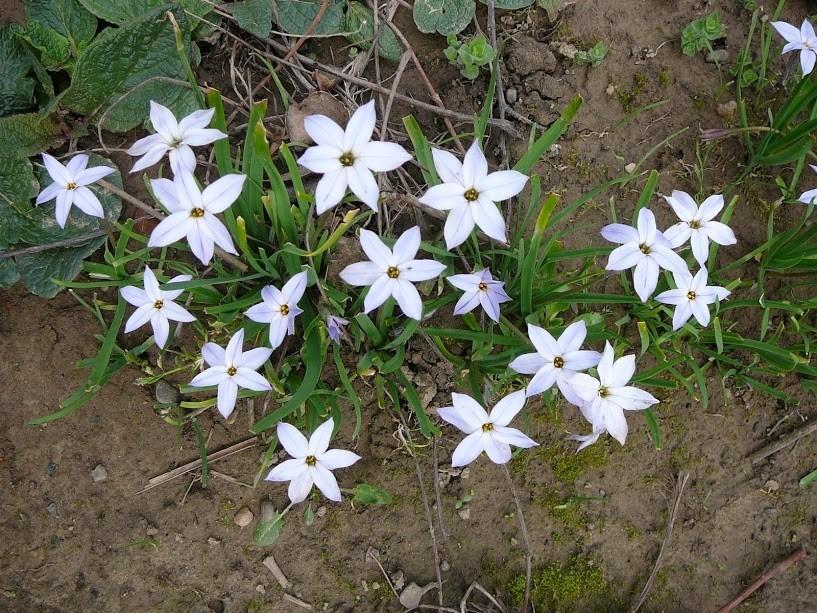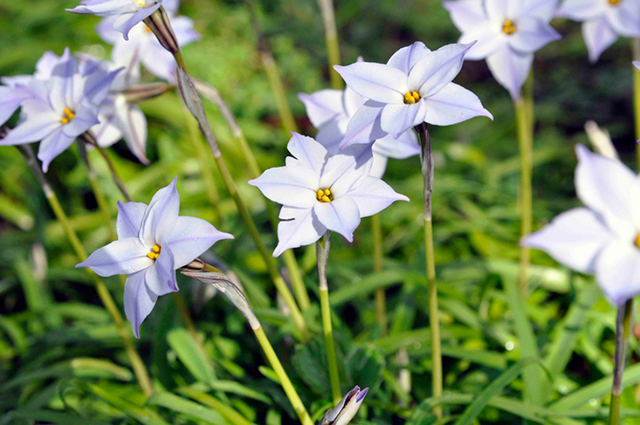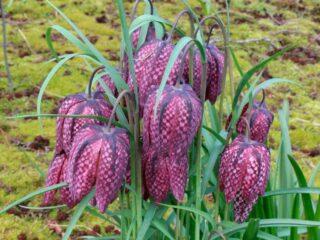Content
Ifheion, ifheron, or tristagma, is a pretty perennial of compact size. This plant will become a real pearl of any site. The subtropics of South America are considered the birthplace of Ifaeion. A photo and description of ifeion will help you learn more about the flower, the features of its planting and the organization of proper care.
Description of the ifeion flower with photo
Ipheion flower (Ipheion uniflorum) is an early flowering bulbous perennial that belongs to the Amaraliaceae family. It is also called “Spring Star”, or “Garlic of the Incas”. The fragrant, star-shaped, blue, white or pinkish-lilac flowers are among the first to bloom of the year. In a temperate climate, this occurs in April-May, in the South - in March-April. Flowering lasts 2-3 months.
The leaves resemble a tender grass and are edible and taste similar to onions. The plant got its name because it has one flower. The leaves give off a garlicky scent that can be smelled when crushed. Peduncles are straight, thin, reaching a height of 10-30 cm.Small star-shaped flowers grow 1-4 cm in diameter. The black center contrasts with the yellowish stamens.
In the wild, the ifeion flower grows in the high mountain meadows of Argentina. It acclimatizes everywhere, spreading throughout the world. The petals can be lavender blue, cobalt blue, mauve or purplish pink. The ifeion flower emits a sweet honey aroma. Leaves with a smooth surface of emerald color reach a length of 20-30 cm.
Types and best varieties
In decorative floriculture, only one species of the Amaraliceae family has found application, and this is Ifaeion uniflorum. The remaining varieties are not yet particularly familiar to gardeners from the CIS countries. Plants are found mainly in wild conditions. Most species are poorly studied by breeders and botanists. In total, there are about 25 species of representatives of the Amaraliceae family.
Charlotte Bishop
The Charlotte Bishop variety is characterized by delicate pink flowers with a darker stripe down the middle of each petal. In buds they are dark pink, becoming lighter as they bloom.

Ifeion Charlotte Bishop is distinguished by a soft pink color
Jessie
The Jessie variety produces sky blue flowers. Argentina is considered the birthplace of the ornamental plant.

Jessie's petals are blue with a blue stripe in the center.
Album
The Album variety of ifeyon is distinguished by snow-white petals. The plant has small flowers.

In cloudy weather, the petals become bluish with a pinkish tint
Wisley Blue
Ifheion Wisley Blue produces lilac-blue flowers with a charming contrasting color. A dark lilac stripe runs along the middle line of the ifeion petals, and they become lighter towards the edges.

Wisley Blue received the RHS Award of Garden Merit
White Star
Ifheion White Star produces white flowers with a soft bluish edge. They are small in size on the plant.

White Star looks very gentle on any flower bed
Rolf Fidler
Rolf Fiedler's flowers are bluish and form wide petals. They are wider than other varieties.

Ifeyon Rolf Fiedler has received many awards
Alberto Castilio
Variety Alberto Castillo is characterized by snow-white flowers and an olive-green thin stripe down the center of the leaves. This is one of the most popular varieties of the Amaraliceae family.

Alberto Castillo got his name from the ifeion flower in honor of the owner of the botanical garden in Buenos Aires
The gardener-breeder was the first to plant this species in 1980.
Mixtures of colors of different varieties of bulbous perennials, bred by crossing them, are also sold.
Planting ifheion in open ground
The miniature perennial Spring Star prefers to grow in sun or partial shade and is famous for its hardiness. The flower takes root in almost all types of soil, even dry and calcareous. The main thing is that there is no stagnant water on the territory. Ifeyon loves hot and dry summers and does not tolerate heavy, waterlogged soil in winter. Bulbs can be grown even by an inexperienced gardener. The flower easily tolerates heat and drought, but cannot withstand frost. If you cover the crop for the winter, the plant can be grown in central Russia.
Planting material should be planted in the soil in September or October, when the ground is still warm and there are no night frosts. Then the root system of the plant will have time to develop before the first cold weather. If we are talking about spring planting, it is worth doing it in April.The soil should be well-drained and light. It is advisable to add leaf humus to the holes before planting.
Planting algorithm:
- Ifeion bulbs are planted in pre-plowed soil to a depth of 5-6 cm. The distance between them should be at least 10 cm.
- After the perennial bulbs are buried in the ground, they are watered with settled water. You will need about 0.5 liters per plant.
Caring for Ifeion in the open ground

Ifeion flower does not require much care
The main condition for the successful development of ifeyon is to provide the plant with an almost dry, cool period of “hibernation”, proper irrigation and fertilizing during active growth. Otherwise, the growing rules are very standard:
- The small-bulbed Ifeion plant needs intense but diffused lighting. Any shading entails lodging of the deciduous mass.
- Ifeion is watered once a week during the growing season in spring and summer. During the dormant stage, the frequency of irrigation is reduced. Stop watering the flower after flowering. If the season turns out to be rainy, it is not necessary to add moisture. The plant needs enough moisture from the ground.
- It is necessary to regularly remove wilted flowers. This encourages new growth and flowering throughout the season.
- It is necessary to periodically plow the ground with half a spade to remove weeds. Soil aeration is also stimulated. After each watering or rain, loosen the soil.
- Ifheion is replanted in August-September every three years to thin out too dense plantings.You must first make sure that the new location has well-drained soil and that the plant receives enough sunlight. This way you can prevent root rot of the crop. When transplanting, carefully remove the flower with a lump of earth and transplant it to a new place by transferring it. Add a slow-release fertilizer to the soil around the root circle.
- From March until the buds open, 3-4 feedings should be done. It is necessary to use mineral complexes for flowering garden crops.
- Ifheion can withstand temperatures down to -10 degrees. In the South, where winters are warm, it is not necessary to build a shelter. If the region experiences lower temperatures, the bushes should be mulched with a thick layer of sawdust, spruce branches, straw or humus. The top of the plants is covered with non-woven material, for example, lutrasil. The shelter is removed after the snow thaws (late March or early April).
If you follow these simple rules, you will be able to grow a lushly blooming “Spring Star”, which will delight the eye with pretty flowers for a long time.

You can buy ready-made shelters for flowers in garden stores.
Reproduction methods
Single-flowered ifheion is usually propagated by baby bulbs. This is a fairly simple method that does not require much effort. After digging up the bush, you should not leave the bulbs outside so that the roots do not dry out. They can spend a maximum of up to 5 days outside the soil at a temperature of +18-20 degrees. The place where the flower is stored should be protected from the wind. It is better to place the planting material in damp sand or soil. Then the flower roots will last as long as possible.
When propagating ifeion, follow planting recommendations depending on the growing environment - in a room or in a garden.In the first year of life, the rhizome of the flower is still weak, few shoots will form, but over time, they will get stronger. Even the smallest bulbs can be planted, taking into account the fact that they will soon bear children. You need to leave a distance between them, as when landing.
You can try to propagate ifeyon by seeds, but this is a very labor-intensive and time-consuming method. It is much easier and faster to resort to the parent method. “Spring Star” is prone to self-seeding, which will still have to be fought.

Reproduction of a flower by baby bulbs will allow you to grow a plant with the same varietal characteristics, which is not always guaranteed with the seed method
Diseases and pests
Single-flowered ifheion is famous for its strong immunity, which weakens with improper care:
- The plant can be attacked by spider mites and aphids. When the first signs of flower damage by beetles are detected, it is necessary to treat with an insecticide solution. Effective drugs include Fufanon, Vermitec, Apollo and Nissoran.
- Rot sometimes appears on flower bulbs. This usually happens when the plant is overwatered or grown in poorly drained soil. Heavy rains often provoke rotting of bulbs. The rotten flower needs to be dug up, healthy bulbs selected and treated with Horus or Fitosporin-M fungicides. You can also use Bordeaux mixture, a solution of copper sulfate. After this, the plant is transplanted to a new place with good drainage.
It is also worth periodically treating ifeyon bushes with special preparations for prevention. Then the single-flowered perennial will not be afraid of any diseases or insects.
Application in landscape design
The charming ifeion looks gorgeous on any site.Flowers are often planted at the foot of shrubs, in rock gardens, rock gardens or along borders. You can also plant plants in pots near other bulbous crops - daffodils, tulips, hyacinths.

The miniature tristagma looks harmonious against the background of stones
Conclusion
A photo and description of Ifeion will allow you to find out all the interesting details about the culture. This is a rare bulbous plant with miniature flowers. It comes from the subtropics. Perennial ifeion bushes do not require special care. Plants do not tolerate frosts and soils with poor drainage.








